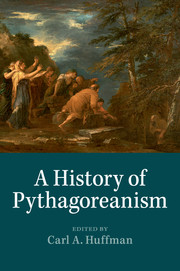Book contents
- Frontmatter
- Contents
- Contributors
- Abbreviations
- Introduction
- Chapter 1 Pythagoras
- Chapter 2 Philolaus
- Chapter 3 Archytas
- Chapter 4 Sixth-, fifth- and fourth-century Pythagoreans
- Chapter 5 The Pythagorean society and politics
- Chapter 6 The Pythagorean way of life and Pythagorean ethics
- Chapter 7 Pythagoreans, Orphism and Greek religion
- Chapter 8 The problem of Pythagorean mathematics
- Chapter 9 Pythagorean harmonics
- Chapter 10 The Pythagoreans and Plato
- Chapter 11 Aristotle on the “so-called Pythagoreans”: from lore to principles
- Chapter 12 Pythagoreanism in the Academic tradition: the Early Academy to Numenius
- Chapter 13 The Peripatetics on the Pythagoreans
- Chapter 14 Pythagoras in the historical tradition: from Herodotus to Diodorus Siculus
- Chapter 15 The pseudo-Pythagorean writings
- Chapter 16 Pythagoreans in Rome and Asia Minor around the turn of the common era
- Chapter 17 Diogenes Laertius’ Life of Pythagoras
- Chapter 18 Porphyry's Life of Pythagoras
- Chapter 19 Iamblichus’ On the Pythagorean Life in context
- Chapter 20 Pythagoras and Pythagoreanism in late antiquity and the Middle Ages
- Chapter 21 Pythagoras in the Early Renaissance
- Bibliography
- General index
- Index locorum
- Greek index
Chapter 15 - The pseudo-Pythagorean writings
Published online by Cambridge University Press: 05 May 2014
- Frontmatter
- Contents
- Contributors
- Abbreviations
- Introduction
- Chapter 1 Pythagoras
- Chapter 2 Philolaus
- Chapter 3 Archytas
- Chapter 4 Sixth-, fifth- and fourth-century Pythagoreans
- Chapter 5 The Pythagorean society and politics
- Chapter 6 The Pythagorean way of life and Pythagorean ethics
- Chapter 7 Pythagoreans, Orphism and Greek religion
- Chapter 8 The problem of Pythagorean mathematics
- Chapter 9 Pythagorean harmonics
- Chapter 10 The Pythagoreans and Plato
- Chapter 11 Aristotle on the “so-called Pythagoreans”: from lore to principles
- Chapter 12 Pythagoreanism in the Academic tradition: the Early Academy to Numenius
- Chapter 13 The Peripatetics on the Pythagoreans
- Chapter 14 Pythagoras in the historical tradition: from Herodotus to Diodorus Siculus
- Chapter 15 The pseudo-Pythagorean writings
- Chapter 16 Pythagoreans in Rome and Asia Minor around the turn of the common era
- Chapter 17 Diogenes Laertius’ Life of Pythagoras
- Chapter 18 Porphyry's Life of Pythagoras
- Chapter 19 Iamblichus’ On the Pythagorean Life in context
- Chapter 20 Pythagoras and Pythagoreanism in late antiquity and the Middle Ages
- Chapter 21 Pythagoras in the Early Renaissance
- Bibliography
- General index
- Index locorum
- Greek index
Summary
Preliminary considerations
After the disappearance of the original society in the fourth century BC, Pythagoreanism survived only sporadically, mostly through individual personalities who continued to lead a Pythagorean way of life; the very existence of actual Pythagorean communities prior to the first-century BC revival is highly conjectural. What is well attested instead is a cultural interest in Pythagorean teachings, as evidenced by the writing of apocrypha, a phenomenon that gradually grew to impressive proportions. The apocryphal sources that have reached us by far outnumber the few fragments that can claim to belong to early Pythagoreans. This apocryphal literature is extremely varied and includes philosophical treatises, collections of precepts and sayings, and short poems such as the famous Golden Verses attributed to Pythagoras himself.
According to Zeller's hypothesis, which dominated scholarship for a long time, this literature has its roots in the Pythagorean revival that occurred in Alexandria in the first century BC. Later studies, however, came to view this material under a different light, rejecting the hypothesis of a common origin and dating. Pythagorean forgeries were already circulating by the third century BC, and the production of apocrypha extended over a long period of time. Such varied material reflects the heterogeneous character of Pythagoreanism: originally a way of life (bios), it later acquired the features of a philosophical doctrine, initially thanks to Philolaus and Archytas but then largely through the influence of the Academy and the doxographical tradition.
Keywords
- Type
- Chapter
- Information
- A History of Pythagoreanism , pp. 315 - 340Publisher: Cambridge University PressPrint publication year: 2014
- 10
- Cited by



